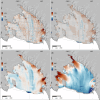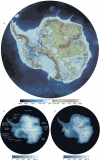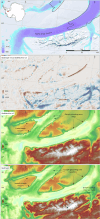Bedmap3 updated ice bed, surface and thickness gridded datasets for Antarctica
- PMID: 40064916
- PMCID: PMC11893747
- DOI: 10.1038/s41597-025-04672-y
Bedmap3 updated ice bed, surface and thickness gridded datasets for Antarctica
Abstract
We present Bedmap3, the latest suite of gridded products describing surface elevation, ice-thickness and the seafloor and subglacial bed elevation of the Antarctic south of 60 °S. Bedmap3 incorporates and adds to all post-1950s datasets previously used for Bedmap2, including 84 new aero-geophysical surveys by 15 data providers, an additional 52 million data points and 1.9 million line-kilometres of measurement. These efforts have filled notable gaps including in major mountain ranges and the deep interior of East Antarctica, along West Antarctic coastlines and on the Antarctic Peninsula. Our new Bedmap3/RINGS grounding line similarly consolidates multiple recent mappings into a single, spatially coherent feature. Combined with updated maps of surface topography, ice shelf thickness, rock outcrops and bathymetry, Bedmap3 reveals in much greater detail the subglacial landscape and distribution of Antarctica's ice, providing new opportunities to interpret continental-scale landscape evolution and to model the past and future evolution of the Antarctic ice sheets.
© 2025. The Author(s).
Conflict of interest statement
Competing interests: The authors declare no competing interests.
Figures












References
-
- FitzGerald, D. M., Fenster, M. S., Argow, B. A. & Buynevich, I. V. Coastal impacts due to sea-level rise. Annu. Rev. Earth Planet. Sci.36, 601–647 (2008).
-
- Rignot, E. & Thomas, R. H. Mass balance of polar ice sheets. Science297, 1502–1506 (2002). - PubMed
-
- Pollard, D. & DeConto, R. M. Modelling West Antarctic ice sheet growth and collapse through the past five million years. Nature458, 329–332 (2009). - PubMed
-
- Coxall, H. K., Wilson, P. A., Pälike, H., Lear, C. H. & Backman, J. Rapid stepwise onset of Antarctic glaciation and deeper calcite compensation in the Pacific Ocean. Nature433, 53–57 (2005). - PubMed
-
- DeConto, R. M. & Pollard, D. Contribution of Antarctica to past and future sea-level rise. Nature531, 591–597 (2016). - PubMed

